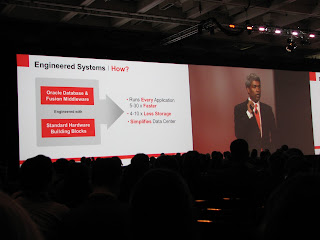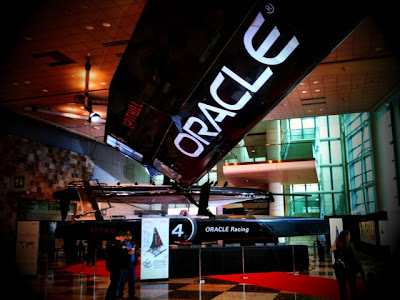I can’t believe Openworld has come and gone. The last two days were a blur! With the appreciation event and traveling home I didn’t get a chance to post a summary. And of course, once I made it back home I had a ton of family activities, work to catch up on, etc. So I’m only getting around to going over my notes now. Since the presentations are available online, I thought I would still talk about some of the sessions I’d recommend downloading.
On Wednesday I attended 3 presentations, I skipped one so I could like up like a fanboi for Larry’s keynote. On Sunday night I managed to pick absolutely the worst seat in the hall. (The camera people were directly in front of me, which blocked my view of the stage and the pillars on each side blocked the screen showing the speakers!) So I wanted to make sure I sat in a good section.
The first presentation I attended was Oracle E-Business Suite Technology Vision, Roadmap, and Customer Successes by Lisa Parekh. Unfortunately tho, I hadn’t intended on going there. I was in a rush, they scanned my badge, it showed green and I went on in. It was a good session tho and provided a lot of information on their priorities, such as ease of use, security and performance. There is a lot of information in this presentation and its available for download here: https://oracleus.wingateweb.com/published/oracleus2011/sessions/17248/S17248_1609600.pdf
My next session was Best Practices for Maintaining and Troubleshooting Oracle Fusion Applications. I quickly discovered tho that Fusion Applications != Fusion Middleware. Luckily tho, Lisa (from the last presentation) mentioned an EBS Patching session. So I left and went over to that one.
Oracle E-Business Suite Directions: Slashing Downtimes with Online Patching, presented by Kevin Hudson was very informative. This was a very detailed session getting down to how patching works underneath. In a nutshell patching will take place while the environment remains online and a quick bounce after for the cutover.
Behind the scenes there will now be two APPL_TOP’s. One will be the called the Run Edition and the other the Patch edition. As the name says, the patch edition will be used for patching and the run edition is currently used by the application. After applying a patch you cutover to the patch edition, which now becomes the run edition.
One thing I liked was that after applying a patch you don’t have to do the cutover right away. You can wait until scheduled downtime. So, you could apply the patch during business hours (if it doesn’t affect performance much) and do a quick bounce off hours.
Some points raised by questions from attendees :
- In the future it may be possible to roll back patches.
- At any point until you cutover you can abort the patch.
- Shared APPL_TOP still supported but now you’ll be sharing a dual filesystem.
- You can still merge patches.
If you’re an EBS DBA then you should read this presentation as it really digs down into how online patching works behind the scenes:
https://oracleus.wingateweb.com/published/oracleus2011/sessions/17255/17255_Cho139369.pdf
 Next was Larry’s keynote. It was probably the most entertaining one he had in quite a few years. The last time I remember it being like this was many years ago bashing Microsoft. This time Salesforce.com was the unlucky recipient. My favorite quote: “Sticker than a roach motel!” I left towards the end of the keynote because it was starting to overlap the last session of the day.
Next was Larry’s keynote. It was probably the most entertaining one he had in quite a few years. The last time I remember it being like this was many years ago bashing Microsoft. This time Salesforce.com was the unlucky recipient. My favorite quote: “Sticker than a roach motel!” I left towards the end of the keynote because it was starting to overlap the last session of the day.
The last session I attended on Thursday was Oracle Enterprise Manager Deployment Best Practices. Best practices such as having multiple OMSs so that you don’t have a single point of failure either due to an outage or change. A common mistake is to distribute OMSs in geographically separate locations under the assumption that it will improve performance. Its recommended to keep your OMSs and repository close since performance is better and agents can tolerate the latency.
If you are in the planning phase of a new Grid Control implementation plan on an incremental rollout, “big bang” deployments are harder to deliver. Monitoring the EM environment is important such as the status of DBMS_SCHEDULER, housekeeping tasks, incoming loader backlog notifications, etc.
One feature talked about, which has been around for awhile, was out of band notifications. When setup, this feature allows an agent to monitor the OMS and send an email notification if it goes down. The metalink note on how to set it up can be found here:
Setting Up Out of Bound (OOB) Notification for 'OMS and Repository' Target in Grid Console [ID 429257.1]
The session also covered some new features of 12c.
 Before heading out to the appreciation event concert I stopped by the hotel for a jacket and a quick video chat with the family. I thought a jacket on top of the sweater I had on all day was enough. You think I would have known since this wasn’t my first trip to Treasure Island! Anyways, thankfully they had patio heaters setup everywhere so after watching Sting perform I met up with some friends for some food and watch them make fools of themselves trying to win some stuff toys.
Before heading out to the appreciation event concert I stopped by the hotel for a jacket and a quick video chat with the family. I thought a jacket on top of the sweater I had on all day was enough. You think I would have known since this wasn’t my first trip to Treasure Island! Anyways, thankfully they had patio heaters setup everywhere so after watching Sting perform I met up with some friends for some food and watch them make fools of themselves trying to win some stuff toys. 




